Clothing Labels and Tags: Grow Your Brand, Not Your Acne
Navigating the world of clothing retail, especially when launching a new brand, involves countless decisions. Among the most crucial, yet often overlooked, are the seemingly small details: labels and tags. These aren’t just identifiers; they’re miniature billboards for your brand, silent salespeople communicating quality, care instructions, and brand story. This article will delve into the universe of clothing labels and tags, covering diverse printing techniques, essential sewing guidelines, measurement considerations, and how to leverage these elements.
Through this article, you will gain:
- A Comprehensive Understanding: Grasp the nuances of different label and tag printing methods.
- Practical How-To’s: Learn the correct procedures for sewing labels and applying tags.
- Size Matters: Understand clothing measurements to create tags.
- Strategic Insights: Discover how to use labels and tags to build your brand identity and connect with customers.
- Business Advice: Get advice to develop a clothing business.
1. What are Clothing Labels and Tags? Defining the Essentials
Clothing labels and tags, while often used interchangeably, serve distinct yet interconnected roles in the garment industry. Let’s break down their definitions and core functions:
Clothing Labels (also called Care Labels or Wash Care Labels): These are typically fabric strips sewn inside a garment. They are legally required in many countries, including the US, to provide crucial information to the consumer. This information includes:
- Fiber Content: The percentage breakdown of materials used (e.g., 100% Cotton, 60% Polyester/40% Cotton).
- Care Instructions: Symbols or written instructions detailing how to wash, dry, iron, and bleach the garment.
- Country of Origin: Where the garment was manufactured.
- RN (Registered Identification Number) or WPL (Wool Products Labeling) Number: A unique identifier for the manufacturer or importer (required in the US).
- Flammability Warning (for some cases)
Clothing Tags (also called Hang Tags): These are usually made of cardstock or thicker materials and are attached externally to the garment, often with a string, plastic fastener, or pin. They are not legally required in the same way as care labels, but they are vital for branding and marketing. Tags typically include:
- Brand Logo and Name: The most prominent element, instantly identifying the brand.
- Size Information: Clearly indicating the garment’s size.
- Price: Often included, especially in retail settings.
- Barcode/QR Code: For inventory management and point-of-sale scanning.
- Style Name/Number: Helps identify the specific garment within a collection.
- Marketing Message: A short tagline, slogan, or description of the brand or garment.
- Website/Social Media: Encouraging customer engagement.
- Materials and Sustainability Information: Increasingly important for eco-conscious consumers.
Understanding the difference between these two is crucial for compliance and effective brand communication. Labels focus on providing essential, legally mandated information, while tags are about attracting attention and building brand identity.
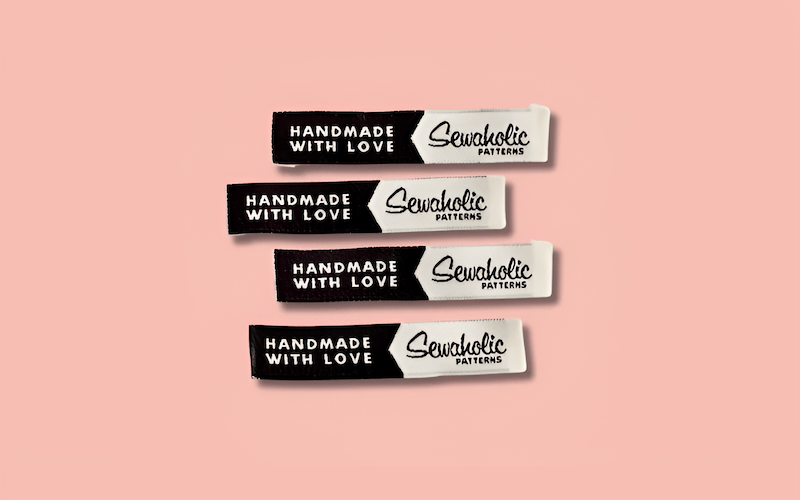
2. Types of Clothing Labels and Printing Technologies
Choosing the right type of label and printing method is a critical decision, impacting both the garment’s aesthetics and its durability. Here’s a breakdown of common options, along with their pros and cons:
2.1 Woven Labels
Description: Woven labels are created by weaving threads together on a loom, resulting in a high-quality, durable label with a textured feel. The design is integrated into the fabric of the label itself.
Pros: Extremely durable, long-lasting, premium look and feel, can withstand repeated washing and wear, ideal for high-end garments.
Cons: More expensive than other options, limited color options (typically up to 8 colors), fine details can be difficult to achieve.
Best For: Luxury brands, outerwear, denim, items requiring high durability.

1. Damask Labels
Description: Damask label is a type of woven label that uses a finer weave and higher thread count than standard woven labels, resulting in a smoother, more detailed finish.
Pros: High-quality, luxurious look and feel, excellent detail reproduction, durable.
Cons: More expensive than standard woven labels.
Best for: High-end garments, lingerie, items where a sophisticated look is desired.
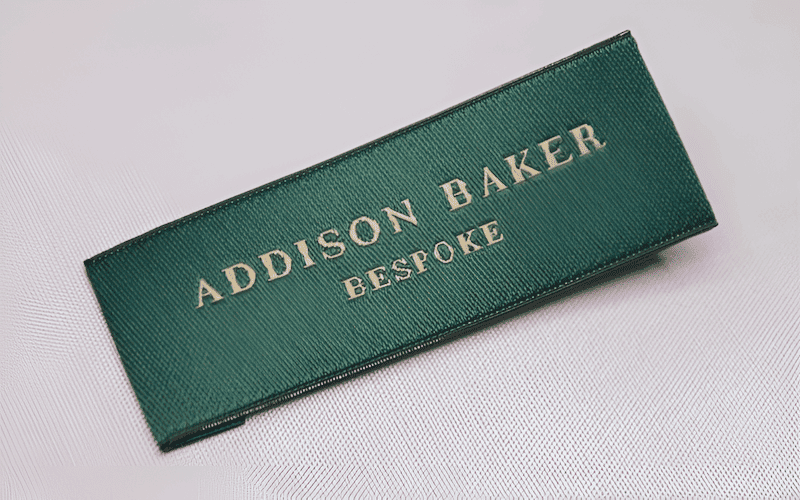
2. Satin Labels
Description: Woven or printed labels made from satin fabric, known for their smooth, shiny surface.
Pros: Soft and comfortable against the skin, elegant appearance.
Cons: Less durable than damask or standard woven labels, may fray easily.
Best for: Lingerie, sleepwear, items where comfort is paramount.
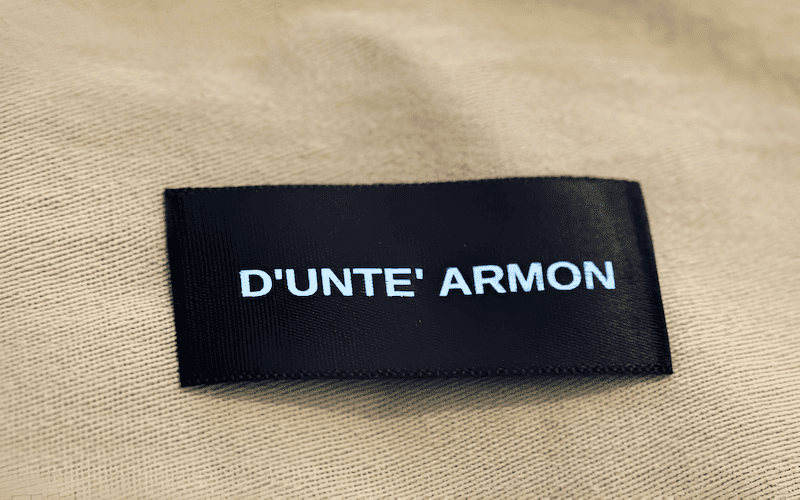
3. Taffeta Labels
Description: Woven labels made from taffeta fabric, which is a crisp, plain-woven fabric with a slight sheen.
Pros: More affordable than damask or satin labels, relatively durable.
Cons: Less soft than satin, can be slightly stiff.
Best for: A wide range of garments, where a balance of cost and quality is needed.
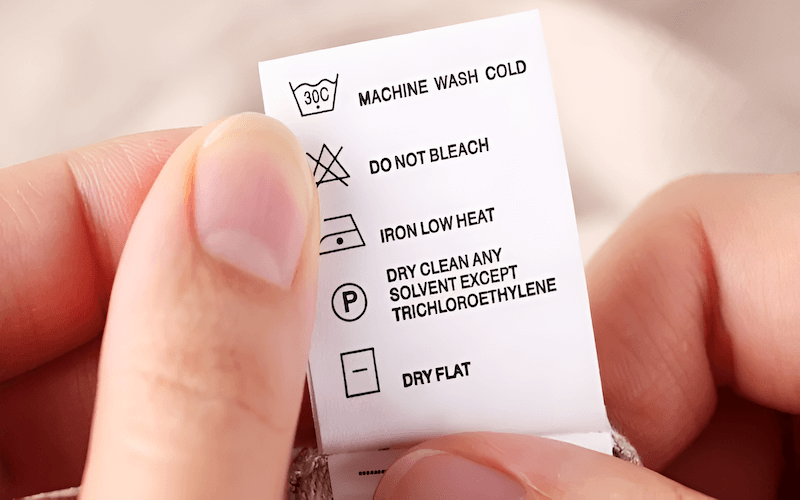
2.2 Printed Labels
Description: The design is printed directly onto the label fabric using various printing techniques.
Types of Printing:
- Screen Printing: Ink is pressed through a mesh screen onto the fabric. Good for bold designs and large quantities.
- Digital Printing: Ink is sprayed directly onto the fabric, similar to an inkjet printer. Ideal for small quantities, complex designs, and photographic images.
- Heat Transfer Printing: The design is printed onto a special transfer paper and then heat-pressed onto the label fabric. Good for full-color designs and gradients.
- Pad Printing: A silicone pad transfers ink from an etched plate onto the label. Suitable for small, intricate designs.
Pros: More affordable than woven labels, can achieve a wide range of colors and intricate designs, faster turnaround times.
Cons: Less durable than woven labels, may fade or crack over time, especially with screen printing.
Best For: T-shirts, casual wear, children’s clothing, items where cost-effectiveness is a priority.

2.3 Choosing the Right Printing Technology
The best printing technology depends on several factors:
- Budget: Woven labels are generally the most expensive, followed by damask, satin, taffeta, and then printed labels.
- Quantity: Digital printing is best for small runs, while screen printing and heat transfer are more cost-effective for larger quantities.
- Design Complexity: Digital and heat transfer printing can handle intricate designs and gradients, while woven labels are better for simpler designs.
- Durability Requirements: Woven labels are the most durable, followed by printed labels with heat transfer or pad printing.
- Lead Time: Printed labels are faster than woven labels.
Carefully considering these factors will help ensure that the label meet your specific needs and budget.
3. Sewing and Attaching Labels and Tags: Best Practices
Properly attaching labels and tags is essential for both functionality and aesthetics. A poorly sewn label can irritate the skin, while a misplaced tag can detract from the garment’s overall appearance. Here’s a guide to best practices:
3.1 Sewing Labels (Care Labels)
Placement:
- Neckline: The most common location, typically centered at the back of the neck.
- Side Seam: Often used for smaller labels or when the neckline is delicate. Place it on the inside of the garment, usually near the bottom hem.
- Waistband: Common for pants, skirts, and shorts.
Sewing Techniques:
- Loop Fold: The label is folded in half, creating a loop, and the raw edges are sewn into the seam. This is the most common and comfortable method.
- End Fold: The label’s ends are folded under, and the folded edges are sewn down. This creates a clean, finished look.
- Mitre Fold: The label’s corners are folded at a 45-degree angle, creating a triangular shape. This is often used for decorative labels.
- Straight Cut: The label is sewn directly onto the garment without any folding. This is the least durable method and can lead to fraying.
Thread Choice: Use a thread color that matches the label or the garment fabric. Polyester thread is generally preferred for its strength and durability.
Stitch Type: A straight stitch or a narrow zigzag stitch is typically used. Avoid using a wide zigzag stitch, as it can make the label bulky and uncomfortable.
Sewing Machine: If you produce in bulk, you should have an industrial sewing machine, it will help the seam become durable.
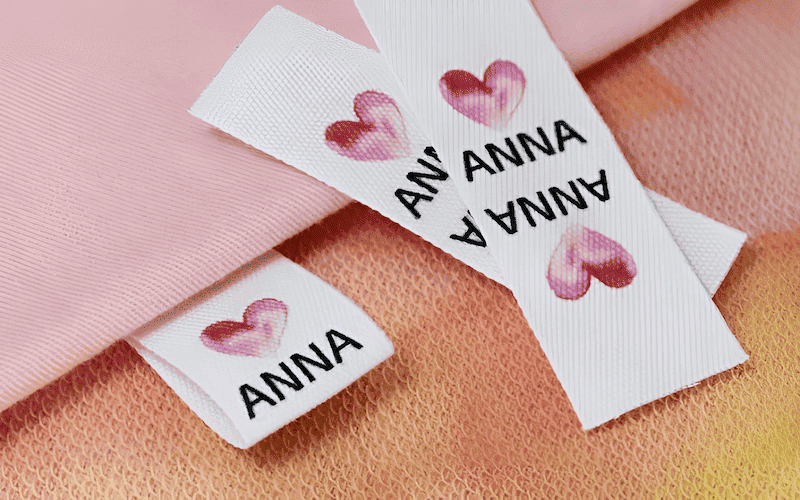
3.2 Attaching Tags (Hang Tags)
Placement:
- Brand Label: Often attached to the brand label at the neckline.
- Side Seam: A discreet location, especially for larger tags.
- Sleeve: Common for T-shirts and other casual wear.
- Buttonhole: If the garment has a buttonhole, the tag can be attached there.
Attachment Methods:
- String/Cord: A classic and versatile option. Use a natural fiber string for a rustic look or a synthetic cord for a more modern feel.
- Plastic Fasteners: Quick and easy to apply, but can be less aesthetically pleasing.
- Safety Pins: A simple and inexpensive option, but can damage delicate fabrics.
- Tag Guns: A specialized tool for attaching plastic fasteners quickly and efficiently.
Considerations:
- Avoid attaching tags to areas that will be in direct contact with the skin, such as the neckline or armhole.
- Ensure the tag is securely attached but can be easily removed by the consumer without damaging the garment.
- Use high-quality materials that won’t bleed or stain the fabric.
By following these guidelines, one can ensure their labels and tags are both functional and enhance the overall presentation of the clothing.
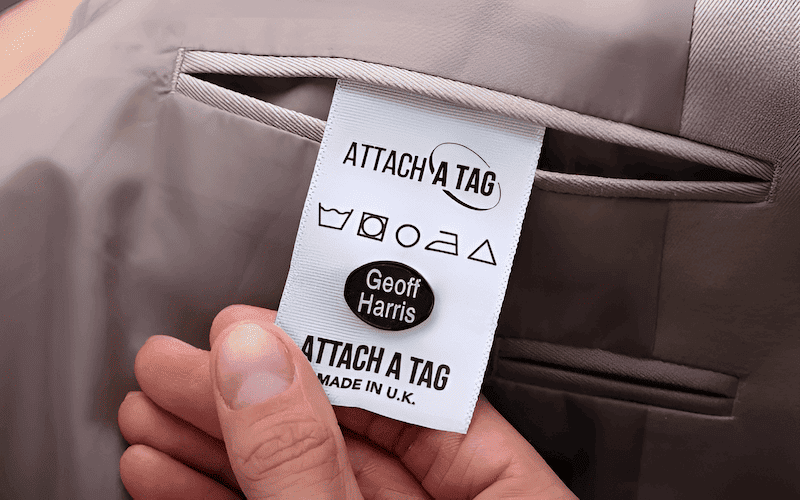
4. Clothing Measurement Guide for Accurate Tagging
Accurate sizing information on tags is absolutely crucial for customer satisfaction and reducing returns. Inconsistent or incorrect sizing can lead to frustration and damage your brand’s reputation. Here’s a guide to clothing measurements and how to present them effectively on tags:
Key Measurements:
The specific measurements needed will vary depending on the type of garment (shirt, pants, dress, etc.). However, here are some of the most common:
For Tops (Shirts, Blouses, Jackets):
- Chest/Bust: Measure around the fullest part of the chest/bust, keeping the tape measure horizontal.
- Waist: Measure around the natural waistline, typically the narrowest part of the torso.
- Hips: Measure around the fullest part of the hips, keeping the tape measure horizontal.
- Sleeve Length: Measure from the shoulder seam to the end of the cuff.
- Shoulder Width: Measure from one shoulder seam to the other, across the back.
- Length: Measure from the highest point of the shoulder (HPS) to the bottom hem.
For Bottoms (Pants, Skirts, Shorts):
- Waist: Measure around the natural waistline.
- Hips: Measure around the fullest part of the hips.
- Inseam: Measure from the crotch seam to the bottom hem (for pants).
- Outseam: Measure from the top of the waistband to the bottom hem (for pants).
- Rise: Measure from the crotch seam to the top of the waistband (for pants).
- Length: Measure from the top of the waistband to the bottom hem (for skirts).
For Dresses
- Include all measures for tops
- Length: Measure from the highest point of the shoulder (HPS) to the bottom hem.
Presenting Measurements on Tags:
- Size Charts: Provide a clear and easy-to-understand size chart, either directly on the tag or as a separate insert. Include measurements in both inches and centimeters.
- Size Labels: Use standard size labels (e.g., S, M, L, XL) or numerical sizes (e.g., 4, 6, 8, 10). Be consistent with your sizing system.
- Fit Descriptors: Consider adding fit descriptors such as “Slim Fit,” “Regular Fit,” or “Relaxed Fit” to help customers choose the right size.
- International Conversions: If selling internationally, provide size conversions for different regions (e.g., US, UK, EU). This avoids confusion.
Best practice
- Measure the sample size carefully to get the correct parameters
- Always double-check the measurement to ensure completely
By providing clear and accurate sizing information, businesses can empower the customer to make informed purchasing decisions, ultimately leading to greater satisfaction and fewer returns.
5. Branding and Marketing with Labels and Tags
Labels and tags are far more than just functional necessities; they’re powerful branding and marketing tools. They offer a unique opportunity to communicate your brand’s identity, values, and story to your customers. Here’s how to leverage them effectively:
5.1 Brand Consistency
- Logo and Color Palette: Your logo should be prominently displayed on both labels and tags. Use your brand’s signature colors consistently to reinforce brand recognition.
- Font and Typography: Choose fonts that reflect your brand’s personality (e.g., modern, classic, playful). Maintain consistent typography across all your labels and tags.
- Overall Design Aesthetic: The design of your labels and tags should align with your brand’s overall aesthetic. If your brand is minimalist, your labels and tags should be too.
5.2 Communicating Brand Values
- Sustainability: If your brand is eco-conscious, use recycled or sustainable materials for your labels and tags. Highlight this on the tag with a message like “Made with Recycled Materials” or “Sustainably Sourced.”
- Ethical Production: If your garments are ethically made, mention this on the tag (e.g., “Fair Trade,” “Ethically Produced”).
- Quality and Craftsmanship: Use high-quality materials and printing techniques for your labels and tags to convey a sense of quality and craftsmanship.
- Unique Selling Proposition (USP): Highlight what makes your brand unique. Is it your use of specific fabrics, your design aesthetic, or your commitment to a particular cause?
5.3 Engaging Customers
- Storytelling: Use the tag to tell a brief story about your brand or the garment. This can create a more personal connection with your customers.
- Social Media Handles: Include your social media handles and website URL to encourage customers to follow you and learn more about your brand.
- QR Codes: Use QR codes to link to your website, product pages, or promotional videos. This can provide customers with additional information and enhance their shopping experience.
- Call to Action: Include a call to action, such as “Share Your Style” or “Tag Us on Instagram,” to encourage user-generated content.
5.4 Creating a Memorable Unboxing Experience
- Packaging: Consider how your labels and tags will look when the garment is packaged. Use high-quality packaging materials and thoughtful presentation to create a memorable unboxing experience.
- Personalized Touches: Add a handwritten note or a small gift to make the customer feel valued.
- Limited Edition or Special Collections: Use unique labels and tags to differentiate limited edition or special collection items.
- Labels and tags contribute to build a cohesive and compelling brand identity.
6. Expert Advice for New Clothing Businesses: Labels, Tags, and Beyond
Starting a clothing business is an exciting venture, but it also requires careful planning and attention to detail. Labels and tags, while seemingly small elements, play a significant role in your brand’s success. Here’s some expert advice to guide you:
6.1 Start with a Strong Brand Identity
Before you even think about labels and tags, define your brand’s core values, target audience, and unique selling proposition. This will inform all your design choices, including your logo, color palette, and typography, which will then be reflected on your labels and tags.
6.2 Prioritize Quality over Cost (Within Reason)
While it’s tempting to cut costs wherever possible, especially when starting out, don’t skimp on label and tag quality. Cheap, poorly made labels can detract from the perceived value of your garments and damage your brand’s reputation. Invest in durable, well-designed labels and tags that reflect the quality of your clothing.
6.3 Understand Legal Requirements
Familiarize yourself with the legal requirements for clothing labeling in your target markets. As mentioned earlier, care labels are mandatory in many countries and must include specific information. Failure to comply can result in fines and legal issues.
6.4 Choose the Right Supplier
Finding a reliable and reputable label and tag supplier is crucial. Look for a supplier who offers a wide range of options, high-quality materials, and excellent customer service. Get samples before placing a large order to ensure you’re happy with the quality and printing. Consider these criteria when choosing the right supplier:
- Experience: Choose a supplier with extensive experience in the label and tag industry.
- Capabilities: Ensure the supplier can handle your specific needs, including printing techniques, materials, and quantities.
- Turnaround Time: Consider the supplier’s lead times to ensure they can meet your production schedule.
- Pricing: Get quotes from multiple suppliers to compare prices and find the best value.
- Customer Service: Choose a supplier with responsive and helpful customer service.
6.5 Design for Readability and Clarity
Labels and tags should be easy to read and understand. Use clear, legible fonts and avoid overcrowding the design with too much information. Prioritize the most important information, such as the brand name, size, and care instructions.
6.6 Think Long-Term
Design your labels and tags with scalability in mind. As your business grows, you’ll want to be able to easily reorder labels and tags without having to redesign them completely. Choose a design that is versatile and can be adapted to different garment types and collections.
6.7 Consider Sustainability
Consumers are increasingly concerned about sustainability, so consider using eco-friendly materials for your labels and tags. This can be a strong selling point for your brand and attract environmentally conscious customers.
6.8 Don’t Overlook Packaging
Packaging is an extension of your brand, and it should complement your labels and tags. Invest in high-quality packaging that protects your garments and creates a positive unboxing experience.
6.9 Test and Iterate
Before launching your clothing line, get feedback on your labels and tags from potential customers. Ask them if the information is clear, if the design is appealing, and if the materials feel high-quality. Use this feedback to make any necessary adjustments.
6.10 Bulk Orders for Cost Savings
Once you’re confident in your label and tag design and have chosen a supplier, consider ordering in bulk to take advantage of volume discounts. This can significantly reduce your per-unit cost. If your business requires a substantial quantity of labels and tags.
Read more:
Labels and tags are integral components of any clothing item, serving far more than a simple identification purpose. They are essential for legal compliance, conveying crucial care instructions, providing accurate sizing information, and, perhaps most importantly, building a strong brand identity.
By carefully considering the various types of labels, printing technologies, attachment methods, and design principles outlined in this guide, both established and emerging clothing businesses can ensure that these small, yet powerful, elements contribute significantly to the overall success and customer perception of their products.
Mastering the art of labels and tags is an investment that pays dividends in brand recognition, customer loyalty, and ultimately, a thriving business in the competitive world of fashion.






















